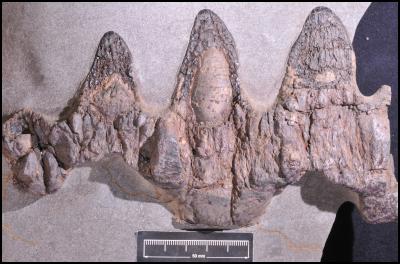Researchers stumble across find with a bite
Researchers stumble across find with a bite

Teeth from a nasty marine predator with a bad attitude from around 80 million years ago are the latest find to come from the fossil-rich Maungataniwha Native Forest in inland Hawkes Bay. Scientists from Wellington-based GNS Science have identified the beast as a mosasaur but the exact species has yet to be determined.
Mosasaurs were large marine reptiles and were the dominant marine predators during the last 20 million years of the Cretaceous period.
While mosasaur fossils have been discovered before in New Zealand they are not particularly common. The first discoveries were in the Waipara, followed by others at Shag Point in Otago and Haumuri Bluff in southern Marlborough.
Fossilised mosasaur teeth were among the many discoveries made from the mid-1970s onwards by celebrated New Zealand palaeontologist Joan Wiffen in the Mangahouanga Stream in Hawkes Bay. Wiffen first discovered evidence of land-dinosaur fossils in New Zealand there and the area has been delivering up interesting discoveries since then.
Maungataniwha is owned by the Forest Lifeforce Restoration Trust (FLRT) which provides direction and funding for the restoration of threatened species of fauna and flora in native forests. Mangahouanga Stream has the bulk of its catchment there.
FLRT forest manager Pete Shaw and DOC biodiversity ranger Helen Jonas were conducting a search for whio (Blue duck) up a small stream and spotted a rock with a lump of bone in it. Jonas was keen to see if the bone extended through the rock and Shaw jumped into a nearby pool to fetch a branch with which to lever the rock loose.
While in the pool Shaw felt something rough and lifted out another rock containing the fossilised jaw fragment.
“There was great jubilation at that point,” Shaw said.
GNS collections manager John Simes said he hoped to have a medical CT scan done of the fragment in order to create a digital 3D model of the teeth, most of which are still hidden in the rock. This digital model would be sent to experts in Canada in a bid to identify the species of mosasaur.
“We’re interested to find out as much as we can,” he said. “Who knows what Pete might have stumbled across. These teeth are twice the size of anything Joan found.”
- ends
–


 Commerce Commission: 2degrees Fined $325,000 For Misleading Claims About ‘Free’ Aussie Business Roaming
Commerce Commission: 2degrees Fined $325,000 For Misleading Claims About ‘Free’ Aussie Business Roaming  Natural Hazards Commission: Hub Launched To Empower Architects And Engineers To Build Above Code
Natural Hazards Commission: Hub Launched To Empower Architects And Engineers To Build Above Code Harmony Energy: Ceremony Heralds Start Of Construction On New Zealand’s Largest Solar Farm Project
Harmony Energy: Ceremony Heralds Start Of Construction On New Zealand’s Largest Solar Farm Project Stats NZ: Annual Number Of Home Consents Down 7.4 Percent
Stats NZ: Annual Number Of Home Consents Down 7.4 Percent Plains Media: Plains FM Announces Name Change After 37 Years
Plains Media: Plains FM Announces Name Change After 37 Years NIWA: Flooding From Underneath - New Tool Reveals Shallow Groundwater Elevations
NIWA: Flooding From Underneath - New Tool Reveals Shallow Groundwater Elevations



